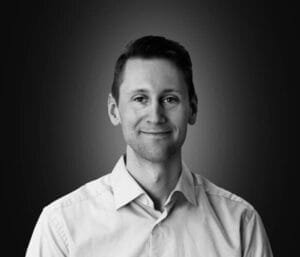Another successful conference was completed last week, with great speakers and an infinite number of rewarding discussions. We at Volupe are very happy to work together with all of you warm and smart simulation engineers. This week’s blog post will give a recap of what was presented during these two days in Gothenburg.
Table of content:
- Keynote speaker, Olof Röhlander
- Tobias Eidevåg, Volvo cars
- Bastian Nebenführ and Felix Larsson, Semcon (Knightec)
- Fredrik Jareman, AFRY
- Per Holmgren, Umeå university
- Jean-Pierre Hamzo, Väderstad
- Frederik Lange Zafiryadis, Aerotak
- Jose Fonseca, FS Dynamics
- Pablo Esquivel de Pablo, Force technology
- Karin Fröjd, Siemens digital industries software
- Peter Segaert, Siemens digital industries software
Keynote speaker, Olof Röhlander
Topic: Sustainable motivation
Olof, being a licensed mental coach from the northern part of Sweden, shared many insightful stories and tips on how to perform better and enjoy what you are doing in life.
Starting the conference, with everyone eager to hear what he had to say, he managed to put words on how to bring out the best in you as a person, and aprofessional, while enjoying what you are doing. The topic Sustainable motivation means when you are working from free will and with an interest in what you are doing. Always making sure that your mental health is prioritized and having at least some short breaks per day to relax mentally will make the difference in performing better and better over time – instead of pushing yourself too hard and losing that inner motivation.
Also remember that your achievements are worth focusing on and letting go of the moments of failure is key to moving forward in the right direction.
With that said, let’s move forward into the technical presentations, enjoy the fascinating work of all our speakers! Finally, remember to attend next year’s conference to enjoy all this engineering candy, live, and to get all the details of the presentations.
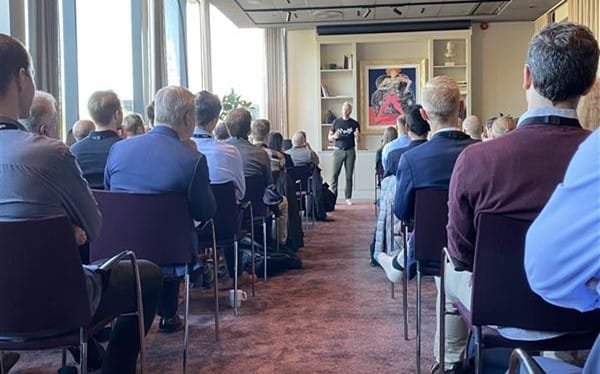
Tobias Eidevåg, Volvo cars
Topic: Snow contamination of cars
Tobias carried out his Ph.D. within CFD (computational fluid dynamics) for calculations about snow contamination of cars. Sharing incredible work in Simcenter STAR-CCM+, showing how he has simulated snow contamination on cars, we could understand how big this problem is since our modern cars are equipped with many sensors and other sensitive features. By developing a workflow of using several passive scalars he can track the field of snow, using DES (detached eddy simulation) for the continuous phase and LMP (Lagrangian multiphase particles) for the snow particles.
One of the conclusions, which is validated with experimental testing as well, is that higher driving speed will create a larger snow cloud behind the car, and thereby less sticking of the snow to the car will be generated. Higher speed will also give rise to increased shear forces, which will rip snow from the car.
P.S. This does not mean that you should drive faster on the slippery roads with snow!
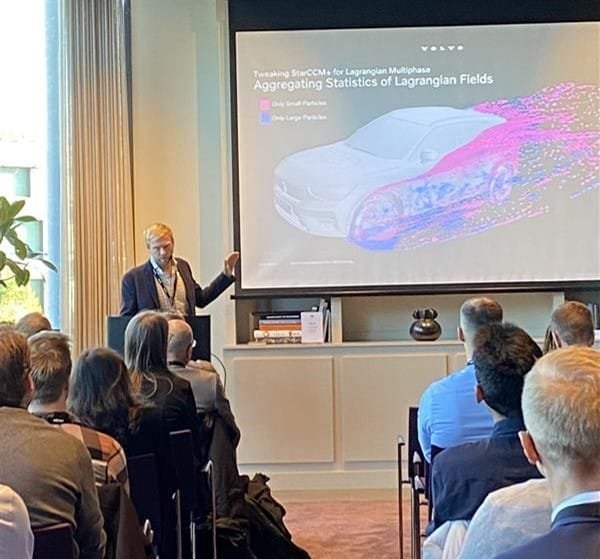
Bastian Nebenführ and Felix Larsson, Semcon
Topic: Thermal comfort modelling
Semcon, after having announced their merging with their sister company Knightec forming Knightec group, presented their project about thermal comfort with local heating inside tables instead of using classical infrared heating lamps. Using the Fiala thermo-regulation model in Simcenter STAR-CCM+, which provides quantitative measurements on how pleasant an environment is perceived, they could show that the new design is better than the classic design. The Fiala thermo-regulation model was added to Simcenter STAR-CCM+ in version 2310.
The presentation felt close to everyone’s heart, since we have all experienced the cold sneaking up on us after a warm day outside, while looking for the best way to enjoy an outdoor dinner. This started a discussion with many good ideas from the crowd.
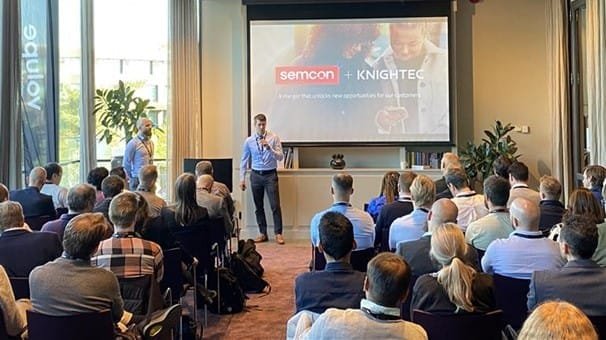
Fredrik Jareman, AFRY
Topic: Combined 3D combustion and 1D system modelling of a pulp mill lime kiln
Fredrik Jareman, who seems to have countless interesting projects going on, amazed us again with AFRY’s lime kiln simulation – where a combination of several-types of physics, co-simulation between software and different length scales were all applied at once.
Inside the large kiln there were geometric features as small 1mm that needed to be resolved, which initially led to a large cell count. Using some tricks it was possible to reduce the mesh size from hundreds of millions of cells to around 10 million cells. This allowed AFRY to perform a combustion simulation in a reasonable amount of time, using Simcenter STAR-CCM+ for complicated physics including multi-component-liquids, radiation, LMP and evaporation.
For the flame, estimations based on engineering know-how from previous projects based on oil and coal as fuel gave insight into how to model the flame. As Fredrik said in the beginning of the presentation, now we no longer need to use “dilution as a solution to pollution”.

Per Holmgren, Umeå university
Topic: Numerical model for limestone burning – progress and challenges
Per was back yet again to show us the progress of his work with his numerical models, meaning another presentation on the hot topic of burning limestone.
One of the reasons this project is very challenging is that the limestones are burning very slowly – forcing the simulations to run for long time, but at the same time the gas is highly turbulent and forcing the time scales to be fast. Reducing the model size is crucial for simulation efficiency, and in this quest Per stumbled upon a limitation for the use of axisymmetry with DEM (discrete element method) particles. Due to these limitations, he decided to settle for a thin cross-sectional model, simplifying the cylindrical shape of the domain.
Using Simcenter STAR-CCM+, DEM particles are modelled as thermally thin – meaning no gradient for the temperature within the particle is per default taken into account. Per’s extensive work with User coding within the software made it possible for him to actually model this gradient, getting results agreeing well with experimental data.
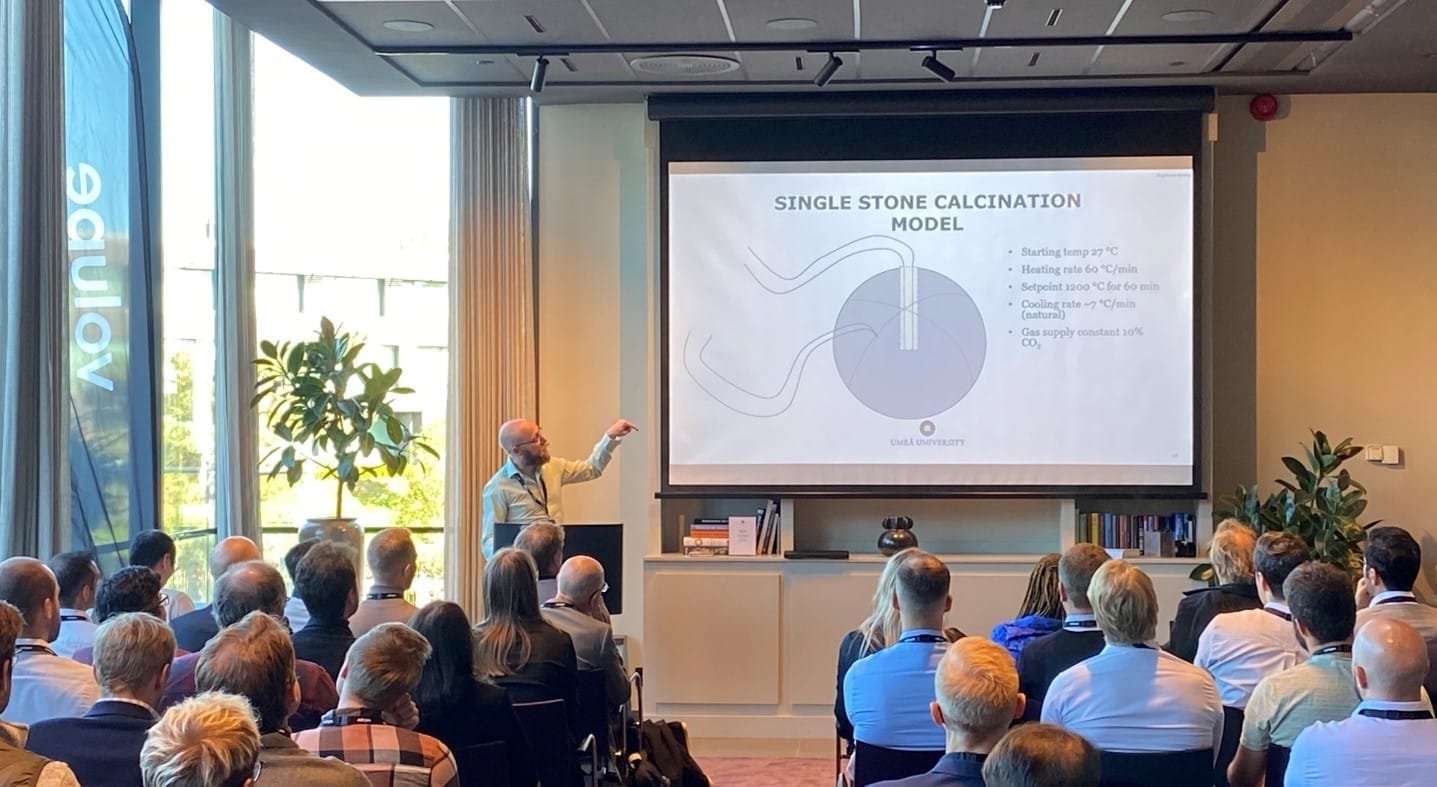
Jean-Pierre Hamzo, Väderstad
Topic: How we at Väderstad use CFD and DEM in our R&D
Väderstad, a Swedish company within agriculture machinery, showed ground-breaking simulations using new features in Simcenter STAR-CCM+. By simulating grains and seeds using polyhedral DEM particles Väderstad can make sure that the seeds end up in the soil with equal spacing, and they can also investigate the erosive wear from seed particles in the tubes transporting the seeds.
Previously, their simulations needed to include a continuous phase for the gas, but now, using meshfree DEM, they can reach a solution much faster. Meshfree DEM also unlocked the possibility to model interaction between soil and plow
One key take-away that Jean-Pierre and his colleagues at Väderstad have experienced is that in experimental testing, out on the fields, it can be very difficult to replicate the same conditions for tests. In CFD you can simulate the product in the same environment using the same BC over and over again. This resulting in uncertainties from external factors are taken out of the equation.

Frederik Lange Zafiryadis, Aerotak
Topic: Pump sump simulation, design and optimization in wastewater treatment plants
Using built-in features for post-processing in Simcenter STAR-CCM+, such as Screenplays, especially for steady state simulations with sweeping planes or mean-field monitors from the last time-steps in a transient simulation, Frederik from Aerotak impressed everyone with his animations when he came up on stage. Aerotak are focusing heavily on advanced multiphase simulations and in the presentation Frederik showed how to combine AMR (adaptive mesh refinement) with VOF (volume of fluid), and sometimes they even are using LMP to model bubbles.
In pump sumps, it is important to avoid bubbles coming into the downstream pumps, and the engineering problem becomes very different depending on the water level of the tank. Sharing results and design improvements, Aerotak showed why they are in the front of simulating these types of simulations. They were able to achieve fast results by utilizing the software’s capabilities on first developing the flow field, then using AMR to get the mesh to a desired level and then changing the time step of a transient simulation.
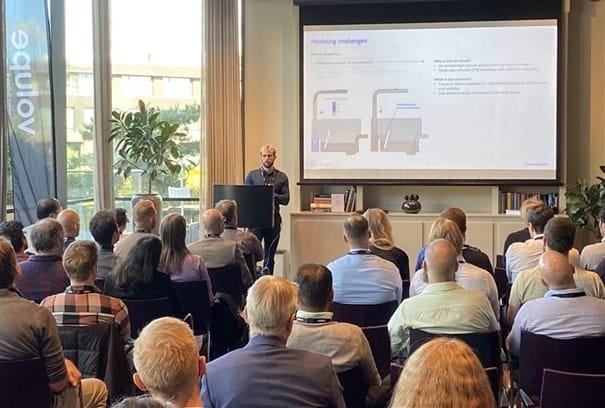
Jose Fonseca, FS Dynamics
Topic: The use of different mesh technologies for CFD analysis of contaminant removal
Jose, who is group manager at FS Dynamics’ Hamburg office in Germany, took us through a breath-taking presentation about chip manufacturing and how to simulate the steps in the production process behind what the whole world is talking about today – chips for AI driven processes.
FS dynamics brought us to the world of micro scales, where milli-kelvin and pico-meters are dominant. The overlays which combine different layers in the chip are a crucial part of signals reaching all components. Today the best chips have 178 layers over 5 micrometers, but soon we will probably have 254 layers with the smallest components of 18 Ångström – 7 atoms in height – and this will bring new challenges as quantum currents are affecting the chips on this scale.
Simulating movement of the manufacturing components using morphing with subsequent remeshing could be very time consuming when needing to remesh every 10th time step. This ,as solved by switching to the overset mesh technique giving a speed-up of 3 times. Using trimmed (hexahedral) cells could provide a speed-up as well, but the polyhedral cells they use are recommended for other types of simulations, and having the same mesh type in all simulations have benefits as well.
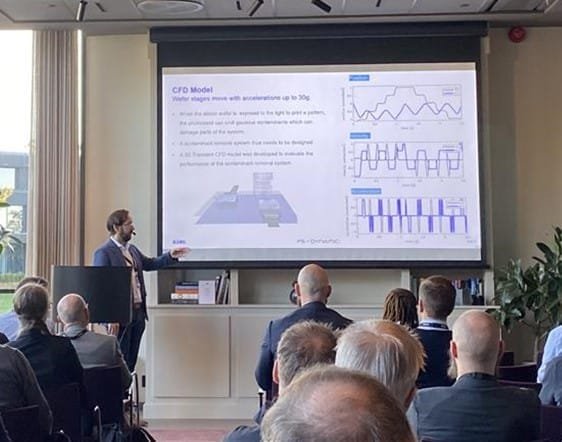
Pablo Esquivel de Pablo, Force technology
Topic: Maritime CFD – Propeller modelling in maneuvering predictions
Pablo shared several insights on simulating turning cycles of large ships using the MRF (moving reference frame) approach in Simcenter STAR-CCM+ for propeller simulations. He highlighted that the turning cycle of a large ship is typically three times the ship’s length and that the propeller rotation direction has a significant impact on the drift angle resulting in different turning circles for left and right turns. Since the propeller is always rotating in the same direction when moving forward you need to calculate the turning cycle both for left and right cycles.
Providing us with an educative and practical explanation on how the source terms in the Navier-Stokes equations are added when using MRF, together with the thorough validation on how interfaces between regions affect the flow field, we could follow the conclusion that MRF is a better approach for this type of simulation than other techniques. Virtual disc model and overset mesh together with RBM (rigid body motion) are also techniques that will allow you to simulate propeller thrust. MRF is not recommended when the fluid flow is far from aligned with the interface normal, but Pablo showed that RBM is also affected – in the same way – when it comes to the rotating flow giving rise to pressure differences in the model.
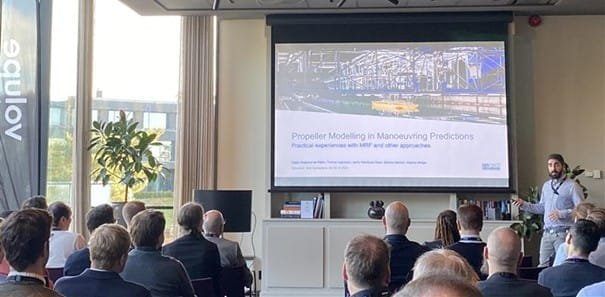
Karin Fröjd, Siemens digital industriers software
Topic: Product roadmap for Simcenter – with focus on Simcenter STAR-CCM+
Karin spoiled us again by showing a lot of amazing features that (most probably) will be included in the Simcenter software within a not too long time frame. The focus was on Simcenter STAR-CCM+, but also connecting Simcenter Amesim to Simcenter E-machine within the EV (electric vehicle) drive cycle was presented.
With all these tools in mind, as Karin so well put it: “Solving the engineering question might be complex, but addressing the solution should not be”.
Some of the areas where Karin presented new features were: FSI (fluid-solid-interaction) deformations, fog simulations using multiphase flow, Battery ion-simulations, Stages in automation workflow, and using AI to help you with your simulations.
P.S. Sorry for not being able to share specific features, but if you are interested in getting the details let’s meet up at next year’s conference!
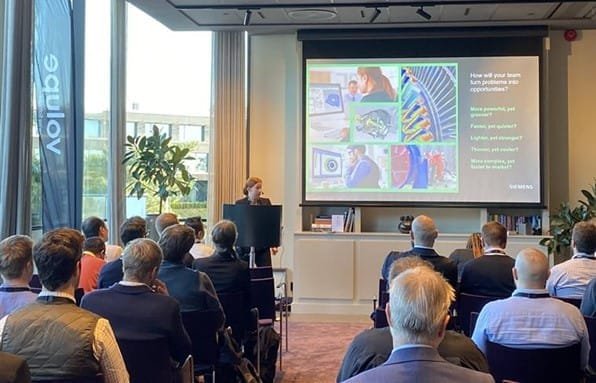
Peter Segaert, Siemens digital industries software
Topic: Simcenter 3D, an integrated multi-physics simulation environment for E-Drive Engineering
The final presentation of the conference, but perhaps the main event for many of our Simcenter 3D users and FEM (finite element method, for structural simulations) engineers, was presented by Peter from Siemens who showed us the strong capabilities of Simcenter 3D (SC3D) – together with Simcenter Testlab.
Peter took us on a journey spanning his career, which started off in the era when you had 8MB of RAM on your computer – leading us up to the point of today’s simulation capabilities before arriving at the main subject of the presentation: The E-Drive workflow. Scratching on its surface, Peter showed how the E-Drive engineering workflow combine capabilities to enable motor and transmission development of electrical powertrains, as well as their NVH (Noise, Vibration and Harshness) performance. The latter was demonstrated both with visual graphs of frequency content as well as with audio synthesized from the simulations.
The applications in the case of NVH were transmissions which could be used in, for example, cars. Showing that depending on model complexity the results can be refined. Going from simpler system models of the transmission, which were able to predict the noise from gears, to more advanced FE (finite element) models. By increasing model fidelity through building an FE model of the gear in SC3D, and calculating its stiffness with SC3D’s Nastran solver, a greater number of excitation frequencies could be detected. Additionally, the more detailed FE model was also integrated into the initial system model of the car. Enhancing the capability to, already at a design stage, be able to predict NVH performance.
Moreover, we got to see the synergy in using Simcenter Testlab in combination with SC3D: Seeing how sensor placement can be calculated via SC3D to find locations with strong response. Thereafter, the positions can be imported to CAD (computer aided design) to ease placement in an actual test, and finally see how the simulation model was able to be correlated to the test via these locations.
The presentation was wrapped up by showing the acoustic capabilities in Simcenter 3D, where Acoustic Transfer Vector (ATV) implementation enhancements were seen to reduce computation time of sound power output from an inverter housing drastically.
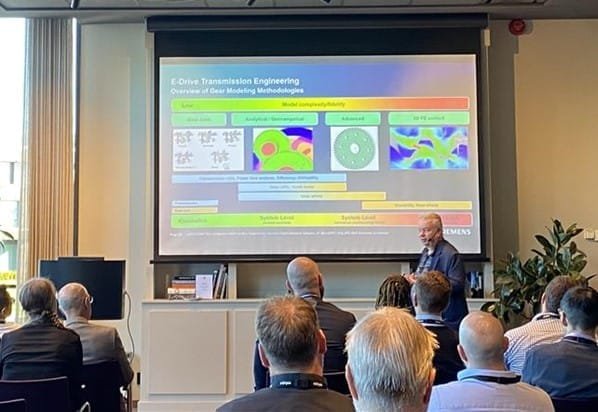
Special thanks to our presenters! And of course, we at Volupe would like to thank all of you who participated as well, asking good questions, bringing up interesting topics for discussion and contributing to a great atmosphere. Let’s hope for an equally pleasant conference next year!
Author
Christoffer Johansson, M.Sc.
support@volupe.com
+46764479945
